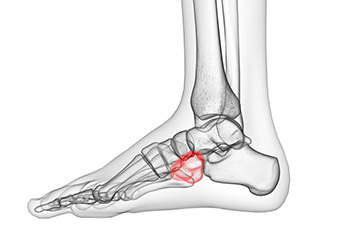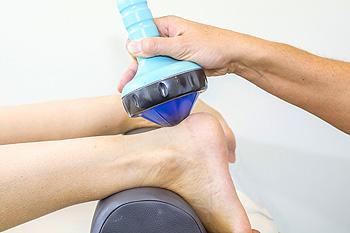Columbus: (614) 866-2477
Gahanna: (614) 939-9330
Lancaster: (740) 653-2656
Newark: (740) 344-8286
North Gahanna: (614) 478-2111
East Columbus: (614) 235-2323
Westerville: (614) 939-9330
Dublin: (614) 339-2000
Pickerington: (614) 545-4321
Lancaster: (740) 653-2656
Items filtered by date: July 2022
What Is Cuboid Syndrome?

In cuboid syndrome, the small, square-shaped cuboid bone on the outside of the midfoot becomes partially dislocated. Cuboid syndrome can cause foot pain in this area, along with weakness in the foot. This condition may occur when the ankle has been sprained or twisted, through overuse/repetitive strain, or by having flat feet. Along with pain and/or foot weakness, there may be redness, swelling, or bruising on the outside of the midfoot. If you suspect that you have cuboid syndrome, contact a podiatrist. They will examine to see exactly where the pain is emanating from. If they determine that you have cuboid syndrome, they may try to treat it with rest, ice therapy, orthotics, and taping. They may even determine that manipulating the bone back into alignment is possible with procedures known as the cuboid whip or the cuboid squeeze. Manipulation is more successful if it is performed shortly after the injury has occurred, so it is important to seek treatment from a podiatrist as soon as possible.
Cuboid syndrome, also known as cuboid subluxation, occurs when the joints and ligaments near the cuboid bone in the foot become torn. If you have cuboid syndrome, consult with one of our podiatrists from Foot & Ankle Specialists of Central Ohio. Our doctors will assess your condition and provide you with quality foot and ankle treatment.
Cuboid syndrome is a common cause of lateral foot pain, which is pain on the outside of the foot. The condition may happen suddenly due to an ankle sprain, or it may develop slowly overtime from repetitive tension through the bone and surrounding structures.
Causes
The most common causes of cuboid syndrome include:
- Injury – The most common cause of this ailment is an ankle sprain.
- Repetitive Strain – Tension placed through the peroneus longus muscle from repetitive activities such as jumping and running may cause excessive traction on the bone causing it to sublux.
- Altered Foot Biomechanics – Most people suffering from cuboid subluxation have flat feet.
Symptoms
A common symptom of cuboid syndrome is pain along the outside of the foot which can be felt in the ankle and toes. This pain may create walking difficulties and may cause those with the condition to walk with a limp.
Diagnosis
Diagnosis of cuboid syndrome is often difficult, and it is often misdiagnosed. X-rays, MRIs and CT scans often fail to properly show the cuboid subluxation. Although there isn’t a specific test used to diagnose cuboid syndrome, your podiatrist will usually check if pain is felt while pressing firmly on the cuboid bone of your foot.
Treatment
Just as the range of causes varies widely, so do treatments. Some more common treatments are ice therapy, rest, exercise, taping, and orthotics.
If you have any questions, please feel free to contact our offices located in Gahanna, Newark, Columbus, and Lancaster, OH . We offer the newest diagnostic and treatment technologies for all your foot care needs.
What Is Cuboid Syndrome?

In cuboid syndrome, the small, square-shaped cuboid bone on the outside of the midfoot becomes partially dislocated. Cuboid syndrome can cause foot pain in this area, along with weakness in the foot. This condition may occur when the ankle has been sprained or twisted, through overuse/repetitive strain, or by having flat feet. Along with pain and/or foot weakness, there may be redness, swelling, or bruising on the outside of the midfoot. If you suspect that you have cuboid syndrome, contact a podiatrist. They will examine to see exactly where the pain is emanating from. If they determine that you have cuboid syndrome, they may try to treat it with rest, ice therapy, orthotics, and taping. They may even determine that manipulating the bone back into alignment is possible with procedures known as the cuboid whip or the cuboid squeeze. Manipulation is more successful if it is performed shortly after the injury has occurred, so it is important to seek treatment from a podiatrist as soon as possible.
Cuboid syndrome, also known as cuboid subluxation, occurs when the joints and ligaments near the cuboid bone in the foot become torn. If you have cuboid syndrome, consult with one of our podiatrists from Foot & Ankle Specialists of Central Ohio. Our doctors will assess your condition and provide you with quality foot and ankle treatment.
Cuboid syndrome is a common cause of lateral foot pain, which is pain on the outside of the foot. The condition may happen suddenly due to an ankle sprain, or it may develop slowly overtime from repetitive tension through the bone and surrounding structures.
Causes
The most common causes of cuboid syndrome include:
- Injury – The most common cause of this ailment is an ankle sprain.
- Repetitive Strain – Tension placed through the peroneus longus muscle from repetitive activities such as jumping and running may cause excessive traction on the bone causing it to sublux.
- Altered Foot Biomechanics – Most people suffering from cuboid subluxation have flat feet.
Symptoms
A common symptom of cuboid syndrome is pain along the outside of the foot which can be felt in the ankle and toes. This pain may create walking difficulties and may cause those with the condition to walk with a limp.
Diagnosis
Diagnosis of cuboid syndrome is often difficult, and it is often misdiagnosed. X-rays, MRIs and CT scans often fail to properly show the cuboid subluxation. Although there isn’t a specific test used to diagnose cuboid syndrome, your podiatrist will usually check if pain is felt while pressing firmly on the cuboid bone of your foot.
Treatment
Just as the range of causes varies widely, so do treatments. Some more common treatments are ice therapy, rest, exercise, taping, and orthotics.
If you have any questions, please feel free to contact our offices located in Gahanna, Newark, Columbus, and Lancaster, OH . We offer the newest diagnostic and treatment technologies for all your foot care needs.
Reminder: When Was the Last Time...?
Reminder: When Was the Last Time...?
What Is Shockwave Therapy for the Feet?

There are many tools at a podiatrist’s disposal to address any number of challenging foot afflictions. Podiatrists may prescribe antibiotics, recommend orthotics, or encourage a surgical procedure in extreme cases. One interesting tool that podiatrists can use is known as shockwave therapy for the feet. This new method can be used to treat plantar fasciitis, one of the most common foot conditions affecting individuals across the country. The shockwave therapy treatment consists of applying bursts of air and electromagnetic shock pulses to the lower limbs in either low or high energy increments. The purpose of this is to facilitate a kind of natural healing response in the feet. That is, the shockwave therapy is meant to encourage the formation of blood vessels in the affected areas and other healing nutrients. If you have plantar fasciitis and believe that you might be interested in addressing it through shockwave therapy, contact a podiatrist who may be able to help.
Shockwave therapy is a treatment commonly used to treat various injuries and conditions, particularly plantar fasciitis in the feet. To learn more, consult with one of our podiatrists from Foot & Ankle Specialists of Central Ohio. Our doctors can provide the care you need to keep you pain-free and on your feet.
Shockwave Therapy
Shockwave therapy is a new treatment option designed to treat bone conditions such as tennis elbow, shoulder pain, and others. Shockwave therapy uses high intensity sound waves that are directed to the affected tissues of the body with pinpoint accuracy. The effects are very beneficial, leading to a production of collagen fibers, eliminating inflammation.
Who Benefits from Shockwave?
Shockwave is recommended for patients suffering from heel pain and associated problems. Heel pain is a common condition which can be caused by obesity, overexertion, and spending a substantial amount of time on hard floors with your feet exposed and unsupported.
Fast and Easy
The therapy is actually a simple process that can leave patients feeling better the very next day. Shockwave therapy is not as dramatic as it sounds. It enables more blood flow to effected areas, addressing the source of the problem and allowing treatment to last for a long time.
Treatment & Recovery Time
Shockwave treatment will enable your feet to recover quickly. This is especially important since surgery is not required. It is cost effective and does not require the use of anesthesia. This treatment is a better option to surgery, since it is proven safe.
If you have any questions, please feel free to contact our offices located in Gahanna, Newark, Columbus, and Lancaster, OH . We offer the newest diagnostic and treatment technologies for all your foot and ankle needs.
What Is Shockwave Therapy for the Feet?

There are many tools at a podiatrist’s disposal to address any number of challenging foot afflictions. Podiatrists may prescribe antibiotics, recommend orthotics, or encourage a surgical procedure in extreme cases. One interesting tool that podiatrists can use is known as shockwave therapy for the feet. This new method can be used to treat plantar fasciitis, one of the most common foot conditions affecting individuals across the country. The shockwave therapy treatment consists of applying bursts of air and electromagnetic shock pulses to the lower limbs in either low or high energy increments. The purpose of this is to facilitate a kind of natural healing response in the feet. That is, the shockwave therapy is meant to encourage the formation of blood vessels in the affected areas and other healing nutrients. If you have plantar fasciitis and believe that you might be interested in addressing it through shockwave therapy, contact a podiatrist who may be able to help.
Shockwave therapy is a treatment commonly used to treat various injuries and conditions, particularly plantar fasciitis in the feet. To learn more, consult with one of our podiatrists from Foot & Ankle Specialists of Central Ohio. Our doctors can provide the care you need to keep you pain-free and on your feet.
Shockwave Therapy
Shockwave therapy is a new treatment option designed to treat bone conditions such as tennis elbow, shoulder pain, and others. Shockwave therapy uses high intensity sound waves that are directed to the affected tissues of the body with pinpoint accuracy. The effects are very beneficial, leading to a production of collagen fibers, eliminating inflammation.
Who Benefits from Shockwave?
Shockwave is recommended for patients suffering from heel pain and associated problems. Heel pain is a common condition which can be caused by obesity, overexertion, and spending a substantial amount of time on hard floors with your feet exposed and unsupported.
Fast and Easy
The therapy is actually a simple process that can leave patients feeling better the very next day. Shockwave therapy is not as dramatic as it sounds. It enables more blood flow to effected areas, addressing the source of the problem and allowing treatment to last for a long time.
Treatment & Recovery Time
Shockwave treatment will enable your feet to recover quickly. This is especially important since surgery is not required. It is cost effective and does not require the use of anesthesia. This treatment is a better option to surgery, since it is proven safe.
If you have any questions, please feel free to contact our offices located in Gahanna, Newark, Columbus, and Lancaster, OH . We offer the newest diagnostic and treatment technologies for all your foot and ankle needs.
Facts About Ankle Sprains and Strains

The ankle joint consists of a complex arrangement of ligaments, tendons, muscles, and bones. It works every time you move your foot, take a step, stand, run or jump. The most common injuries to the ankle joint fall into two categories: sprains and strains. An ankle sprain is caused by a direct injury to ligaments in the joint. They are either stretched beyond their natural limits or torn outright. Strains, on the other hand, are caused by muscles or tendons being stretched too far. They are typically overuse injuries that occur from doing too much, too often, and for too long. Risk factors include poor conditioning, muscle fatigue, inadequate warmup, carrying excess weight, and inappropriate footwear. If not treated and allowed to heal properly, these conditions can become chronic. If your ankle hurts, or if a sore ankle worsens, it is highly suggested that you consult a podiatrist at your earliest convenience.
Ankle sprains are common but need immediate attention. If you need your feet checked, contact one of our podiatrists from Foot & Ankle Specialists of Central Ohio. Our doctors can provide the care you need to keep you pain-free and on your feet.
How Does an Ankle Sprain Occur?
Ankle sprains take place when the ligaments in your ankle are torn or stretched beyond their limits. There are multiple ways that the ankle can become injured, including twisting or rolling over onto your ankle, putting undue stress on it, or causing trauma to the ankle itself.
What Are the Symptoms?
- Mild to moderate bruising
- Limited mobility
- Swelling
- Discoloration of the skin (depending on severity)
Preventing a Sprain
- Wearing appropriate shoes for the occasion
- Stretching before exercises and sports
- Knowing your limits
Treatment of a Sprain
Treatment of a sprain depends on the severity. Many times, people are told to rest and remain off their feet completely, while others are given an air cast. If the sprain is very severe, surgery may be required.
If you have suffered an ankle sprain previously, you may want to consider additional support such as a brace and regular exercises to strengthen the ankle.
If you have any questions please feel free to contact our offices located in Gahanna, Newark, Columbus, and Lancaster, OH . We offer the newest diagnostic and treatment technologies for all your foot and ankle needs.
Facts About Ankle Sprains and Strains

The ankle joint consists of a complex arrangement of ligaments, tendons, muscles, and bones. It works every time you move your foot, take a step, stand, run or jump. The most common injuries to the ankle joint fall into two categories: sprains and strains. An ankle sprain is caused by a direct injury to ligaments in the joint. They are either stretched beyond their natural limits or torn outright. Strains, on the other hand, are caused by muscles or tendons being stretched too far. They are typically overuse injuries that occur from doing too much, too often, and for too long. Risk factors include poor conditioning, muscle fatigue, inadequate warmup, carrying excess weight, and inappropriate footwear. If not treated and allowed to heal properly, these conditions can become chronic. If your ankle hurts, or if a sore ankle worsens, it is highly suggested that you consult a podiatrist at your earliest convenience.
Ankle sprains are common but need immediate attention. If you need your feet checked, contact one of our podiatrists from Foot & Ankle Specialists of Central Ohio. Our doctors can provide the care you need to keep you pain-free and on your feet.
How Does an Ankle Sprain Occur?
Ankle sprains take place when the ligaments in your ankle are torn or stretched beyond their limits. There are multiple ways that the ankle can become injured, including twisting or rolling over onto your ankle, putting undue stress on it, or causing trauma to the ankle itself.
What Are the Symptoms?
- Mild to moderate bruising
- Limited mobility
- Swelling
- Discoloration of the skin (depending on severity)
Preventing a Sprain
- Wearing appropriate shoes for the occasion
- Stretching before exercises and sports
- Knowing your limits
Treatment of a Sprain
Treatment of a sprain depends on the severity. Many times, people are told to rest and remain off their feet completely, while others are given an air cast. If the sprain is very severe, surgery may be required.
If you have suffered an ankle sprain previously, you may want to consider additional support such as a brace and regular exercises to strengthen the ankle.
If you have any questions please feel free to contact our offices located in Gahanna, Newark, Columbus, and Lancaster, OH . We offer the newest diagnostic and treatment technologies for all your foot and ankle needs.
How Do I Prevent Toenail Problems?

Your toenails can tell you a lot about your health, which is why our podiatrists always recommend paying close attention to any changes to your nails. Whether you notice a change in texture, color, smell, or thickness, it could point to a bigger problem that requires treatment.
At Foot and Ankle Specialists of Central Ohio, one of the most common nail issues our foot doctors treat are fungal toenails and ingrown toenails. Treatment for these conditions are especially important for those who have preexisting health issues like diabetes.
Fungal nails
- An infection that is caused by a fungus that grows on or under the nail.
- Symptoms include nails that are brittle, thick, discolored, or have an odor.
- Can spread if not treated.
- Typically treated with antifungal creams, ointments, medicated polish, and/or laser therapy.
Ingrown toenails
- The nail grows into the adjacent fleshy part, causing pain, bleeding, and swelling.
- Commonly seen in the big toenail.
- Often caused by improper nail trimming.
- Treatments include partial or complete surgical removal of the affected nail, and/or antibiotics to treat infections.
These common problems can be prevented by following these tips:
- Keep your feet clean by washing them daily with warm soap. Dry your feet completely, including the area between your toes.
- Always cut your toenails straight across. Don’t round the edges.
- Do not share nail clippers or other tools.
- Wear moisture-wicking socks and shoes.
- Look over your feet everyday for injuries or changes to nails or skin.
- Avoid tight shoes, especially in the toe box area.
- Schedule an appointment with a podiatrist regularly.
Have nail issues?
While some nail issues do not seem to require a visit to a foot doctor, we encourage you to come in for any nail issues so you can get the most effective and fast-acting treatments. Our team of foot doctors have the tools and expertise to get you back on your feet, and can provide specialized treatments and preventative care if you have underlying health issues.
Have toenail concerns, diabetes-related issues, or painful bunions or sports injuries? Get the help you deserve by coming to Foot and Ankle Specialists of Central Ohio! Contact any of our locations in Gahanna, Newark, or Columbus, OH to set up your appointment today!
Children Shoes for Different Stages of Foot Development
 The importance of taking care of babies' feet is crucial to having a strong foundation. Proper foot care started at an early age may help to ensure healthy feet. This can begin by refraining from having children wear shoes while indoors. The toes will grip the floor and this is beneficial in strengthening the overall foot. When the time comes to walk outside, shoes that are lightweight and flexible may be best and can act as protective skin. When a baby starts to walk the foot structure is beginning to develop. Flat feet that most babies are born with may start to diminish and the arch may be seen. The arch will continue to develop through the teenage years. As the baby grows, a sturdier shoe with some flexibility may be desired that can accommodate running and daily wear and tear. When purchasing shoes for your child it is suggested that their feet are properly measured and this is generally done every three months up to the age of three years. If you would like more information about babies' feet and how to properly care for them, please confer with a podiatrist.
The importance of taking care of babies' feet is crucial to having a strong foundation. Proper foot care started at an early age may help to ensure healthy feet. This can begin by refraining from having children wear shoes while indoors. The toes will grip the floor and this is beneficial in strengthening the overall foot. When the time comes to walk outside, shoes that are lightweight and flexible may be best and can act as protective skin. When a baby starts to walk the foot structure is beginning to develop. Flat feet that most babies are born with may start to diminish and the arch may be seen. The arch will continue to develop through the teenage years. As the baby grows, a sturdier shoe with some flexibility may be desired that can accommodate running and daily wear and tear. When purchasing shoes for your child it is suggested that their feet are properly measured and this is generally done every three months up to the age of three years. If you would like more information about babies' feet and how to properly care for them, please confer with a podiatrist.
Making sure that your children maintain good foot health is very important as they grow. If you have any questions, contact one of our podiatrists of Foot & Ankle Specialists of Central Ohio. Our doctors can provide the care you need to keep you pain-free and on your feet.
Keeping Children's Feet Healthy
Having healthy feet during childhood can help prevent medical problems later in life, namely in the back and legs. As children grow, their feet require different types of care. Here are some things to consider...
Although babies do not walk yet, it is still very important to take care of their feet.
Avoid putting tight shoes or socks on his or her feet.
Allow the baby to stretch and kick his or her feet to feel comfortable.
As a toddler, kids are now on the move and begin to develop differently. At this age, toddlers are getting a feel for walking, so don’t be alarmed if your toddler is unsteady or ‘walks funny’.
As your child gets older, it is important to teach them how to take care of their feet.
Show them proper hygiene to prevent infections such as fungus.
Be watchful for any pain or injury.
Have all injuries checked by a doctor as soon as possible.
Comfortable, protective shoes should always be worn, especially at play.
If you have any questions please feel free to contact our offices located in Gahanna, Newark, Columbus, and Lancaster, OH . We offer the newest diagnostic and treatment technologies for all your foot and ankle needs.
Blog Archives
- April 2024
- March 2024
- February 2024
- January 2024
- December 2023
- November 2023
- October 2023
- September 2023
- August 2023
- July 2023
- June 2023
- May 2023
- April 2023
- March 2023
- February 2023
- January 2023
- December 2022
- November 2022
- October 2022
- September 2022
- August 2022
- July 2022
- June 2022
- May 2022
- April 2022
- March 2022
- February 2022
- January 2022
- December 2021
- November 2021
- October 2021
- September 2021
- August 2021
- July 2021
- June 2021
- May 2021
- April 2021
- March 2021
- February 2021
- January 2021
- December 2020
- November 2020
- October 2020
- September 2020
- August 2020
- July 2020
- June 2020
- May 2020
- April 2020
- March 2020
- February 2020
- January 2020
- December 2019
- November 2019
- October 2019
- September 2019
- August 2019
- July 2019


